Kulikov battle. 1380
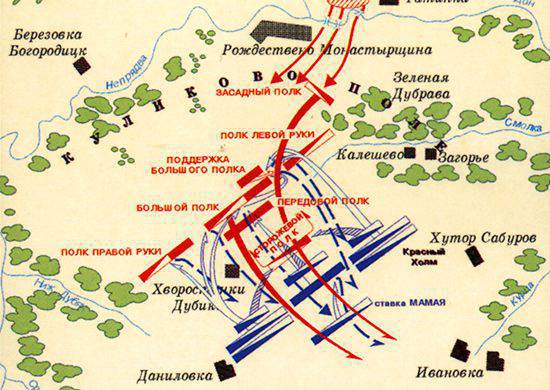
The Battle of Kulikovo (Battle of Mamaevo), the battle between the united Russian army led by Moscow Grand Duke Dmitry Ivanovich and the Temnik army of the Golden Horde of Mamaia, held on September 8, 1380 [1] on the Kulikovo field (historical the area between the rivers Don, Nepryadva and Beautiful Swords in the southeast of the Tula region.
Strengthening of the Moscow principality in the 60-s of the XIV century. and the unification of the rest of the lands of North-Eastern Russia around him proceeded almost simultaneously with the strengthening of the power of Temnik Mamai in the Golden Horde. Married to the daughter of the Golden Horde Khan Berdibek, he received the title of Emir and became the ruler of the fate of that part of the Horde, which was located west of the Volga to the Dnieper and on the steppe expanses of the Crimea and Ciscaucasia.
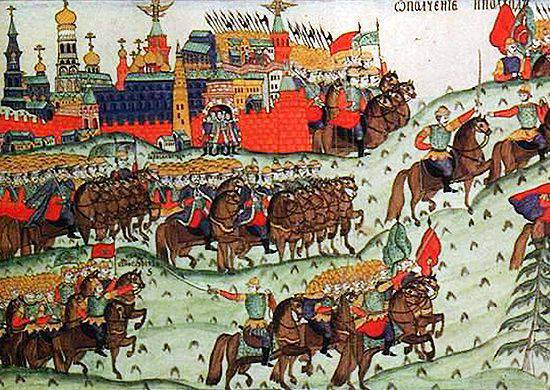
In 1374, the Moscow prince Dmitry Ivanovich, who had a label on the Grand Duchy of Vladimir, refused to pay tribute to the Golden Horde. Then Khan in 1375, gave the label to the great reign of Tver. But virtually all of Northeastern Rus came out against Mikhail Tversky. The Moscow prince organized a military campaign against the principality of Tver, which was joined by Yaroslavl, Rostov, Suzdal and the regiments of other principalities. Dmitry was supported by Novgorod the Great. Tver capitulated. According to the agreement concluded, the Vladimir table was recognized as the “homeland” of Moscow princes, and Mikhail of Tver became a vassal of Dmitry.
However, the ambitious Mamai continued to consider the defeat of the Moscow principality, which had come out of submission, as the main factor in strengthening its own positions in the Horde. In 1376, the Arab Shah Muzaffar (Arapsh of the Russian Chronicles), who had transferred to the service of Mamai Khan of the Blue Horde, ruined the Novosilsk princedom, but returned back, avoiding a battle with the Moscow army that went beyond the Oksky frontier. In 1377, he is on the river. Piana defeated non-Moscow-Suzdal army. Sent against the Horde voivods showed carelessness, for which they paid: “And their princes, and boyars, and grandees, and voivods, consoling and amusing, drinking and catching things, imagining the house being” [2], and then ruining Nizhny Novgorod and Ryazan, executing the house being ”[XNUMX], and then ruining Nizhny Novgorod and Ryazan, the house itself seems to have been ruined, and Nizhniy Novgorod and Nizhny Novgorod and Ryazan were destroyed by Nizhny Novgorod. .
In 1378, Mr. Mamai, trying to make him pay tribute again, sent an army to Russia led by Murza Begich. Speaking to meet the Russian regiments led Dmitry Ivanovich. The battle took place 11 August 1378 g. In Ryazan land on the tributary of the Oka River. Vozhe. Horde were utterly defeated and fled. The battle on Vozha showed the increased power of the Russian state emerging around Moscow.
To participate in the new campaign, Mamai attracted armed detachments from the subjugated peoples of the Volga region and the North Caucasus; his army also had heavily-armed infantry from the Genoese colonies in the Crimea. Allies of the Horde were the great Lithuanian prince Jagailo and the prince of Ryazan Oleg Ivanovich. However, these allies were mental: Yagailo did not want to strengthen either the Horde or the Russian side, and as a result, his troops did not appear on the battlefield; Oleg Ryazansky went to an alliance with Mamai, fearing for the fate of his border principality, but he was the first to inform Dmitry about the advance of the Horde troops and did not participate in the battle.
In the summer of 1380, the town of Mamai began the march. Not far from the place of the confluence of the Voronezh River and the Don Horde, they broke up their camps and, roaming, awaited news from Jagiello and Oleg.
In the terrible hour of danger looming over the Russian land, Prince Dmitry showed exceptional energy in organizing a repulse against the Golden Horde. At his call, military detachments, militias of peasants and townspeople began to assemble. All Russia rose to fight the enemy. The collection of Russian troops was appointed in Kolomna, where the core of the Russian troops marched from Moscow. The courtyard of Dmitry himself, the regiments of his cousin Vladimir Andreevich Serpukhov and the regiments of Belozero, Yaroslavl and Rostov princes went separately along different roads. We moved to the connection with the troops of Dmitry Ivanovich and the regiments of the Olgerdovich brothers (Andrey Polotsky and Dmitry Bryansky, the Yagailo brothers). In the composition of the troops of the brothers were Lithuanians, Belarusians and Ukrainians; townspeople of Polotsk, Drutsk, Bryansk and Pskov.
After the arrival of the rats in Kolomna, a review was conducted. The collected army on the Maiden's field was striking in its multiplicity. The collection of ratias in Kolomna had not only military, but also political significance. Ryazan Prince Oleg finally got rid of the hesitation and abandoned the idea to join the troops of Mamaia and Jagiello. A marching battle order was formed in Kolomna: Prince Dmitry led the Bolshoi Regiment; Prince Vladimir Andreevich of Serpukhov with Yaroslavl - the Regiment of the Right Hand; Gleb Bryansky was appointed commander of the Left Hand Regiment; The advanced regiment consisted of Kolomentsi.
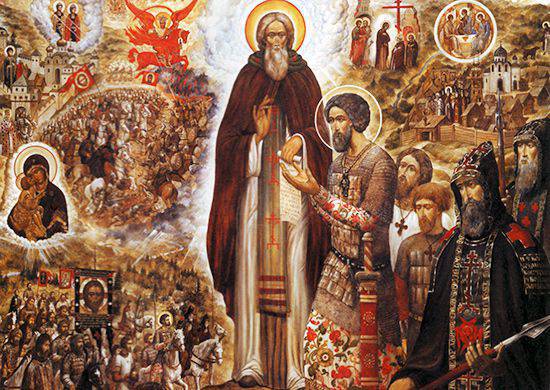
Artist S.B. Simakov. 1988
On August 20, the Russian army set off from Kolomna on a hike: it was important to block the hordes of Mamai as soon as possible. On the eve of the campaign, Dmitry Ivanovich visited Sergius of Radonezh in the Trinity Monastery. After the conversation, the prince and hegumen came out to the people. After leaving the prince with the sign of the cross, Sergius exclaimed: “Go, lord, to the vile Polovtsy, calling on God, and the Lord God will be the assistant and protector” [3]. Blessing the prince, Sergius predicted victory for him, albeit at a high price, and set off to the march of his two monks, Peresvet and Oslaby.
The whole campaign of the Russian rati against the Oka was carried out in a relatively short time. The distance from Moscow to Kolomna, about 100 km, the troops marched in 4 day. To the mouth of Lopasni, they arrived on August 26. Ahead was the guard guard, which had the task of safeguarding the main forces from a sudden attack by the enemy.
30 August Russian troops began crossing the Oka near the village of Priluki. Okolnichy Timofey Vel'yaminov with the detachment exercised control over the crossing, awaiting the approach of a footbag. September 4 30 km from the river Don in the tract Berezuy joined the Russian army allied regiments Andrei and Dmitry Olgerdovich. Once again, the location of the Horde army was clarified, which, in anticipation of the Allies' approach, wandered around Kuzmina Gati.
The movement of the Russian army from the mouth of Lopasni to the west was intended to prevent the Lithuanian army of Yagailo from connecting with the forces of Mamaia. In turn, Yagaylo, learning about the route and the number of Russian troops, was in no hurry to join the Mongol-Tatars, trampling around Odoev. The Russian command, having received this information, resolutely sent troops to the Don, seeking to preempt the connection of enemy units and strike at the Mongol-Tatar horde. September 5 Russian cavalry came to the mouth of the Nepryadva, as Mamai found out only the next day.
To develop a plan for further action 6 September, Prince Dmitry Ivanovich convened a military council. The votes of the council members were divided. Some offered to go beyond the Don and on the southern bank of the river to fight with the enemy. Others advised to stay on the north bank of the Don and wait for the enemy to attack. The final decision depended on the Grand Duke. Dmitry Ivanovich said the following significant words: “Brothers! An honest death is better than an evil life. It was better not to go out against the enemy than, having come and having done nothing, to return back. Let's go over everything today for Don, and there we shall lay our heads for the Orthodox faith and our brother ”[4]. The Grand Duke Vladimirsky preferred offensive actions, which allowed him to keep the initiative, which was important not only in strategy (to beat the enemy piecemeal), but also in tactics (choosing the location of the battle and unexpectedly striking the enemy army). After the council in the evening, Prince Dmitry and voevoda Dmitry Mikhailovich Bobrok-Volynsky moved behind the Don and examined the area.
The area chosen by Prince Dmitry for battle was called Kulikov Field. On three sides — west, north, and east — it was bounded by the Don and Nepryadva Rivers, carved by ravines and small rivers. The right wing of the Russian rati under construction was covered by small rivers that flow into Nepryadva (Upper, Middle and Lower Dubiki); the left is a rather shallow river Small Smolka, flowing into the Don, and the dried beds of streams (beams with gentle slopes). But this lack of topography was compensated - beyond Smolkoy there was a forest in which it was possible to put a general reserve, guarding the fords across the Don and strengthening the wing's battle formation. On the front, the Russian position had a length of over eight kilometers (some authors significantly reduce it and then question the large number of troops). However, the terrain convenient for the cavalry of the enemy was limited to four kilometers and was in the center of the position - near the converging headwaters of Lower Dubik and Smolka. The army of Mamaia, having an advantage in deploying on the front over 12 kilometers, could have cavalry attacked Russian military formations only in this limited area, which excluded the maneuver by cavalry masses.
On the night of September 7 1380, the crossing of the main forces began. Pedestrian troops and convoys passed across the Don across the bridges, the cavalry ford. The crossing was carried out under the guise of strong guard units.
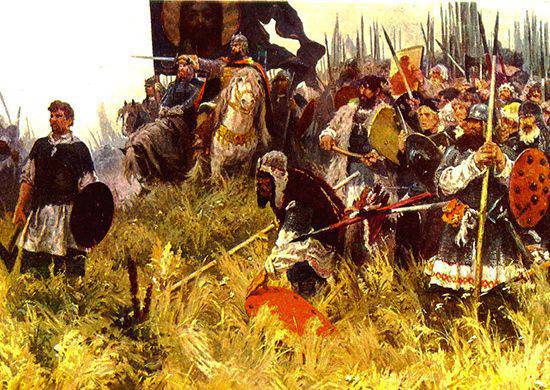
According to the watchmen Seeds Melik and Peter Gorsky, who had a battle with the enemy’s reconnaissance on 7 in September, it became known that Mamai’s main forces were only one transition away and should be expected by Don the next morning. Therefore, so that Mamai did not anticipate the Russian army, already in the morning of September 8, the Russian army, under the guise of the Sentry Regiment, assumed battle formation. On the right flank, adjacent to the steep shores of Lower Dubik, a regiment of the Right Hand, which included the squad of Andrei Olgerdovich, stood up. In the center are the squad of the Big Regiment. They were commanded by the Moscow okolnichy Timofey Veliyaminov. On the left flank, hiding from the east by the Smolkoy River, a regiment of the Left Hand of Prince Vasily Yaroslavsky was built. In front of the Big Regiment was the Advanced Regiment. Behind the left flank of the Big Regiment a reserve detachment commanded by Dmitry Olgerdovich was secretly located. Behind the Left Hand Regiment in the forest area of Green Green Dubrava, Dmitry Ivanovich set up a select cavalry detachment of 10 – 16 thousand [5] - Ambush regiment headed by Prince Vladimir Andreyevich Serpukhovsky and experienced governor Dmitry Mikhailovich Bobrok-Volynsky.
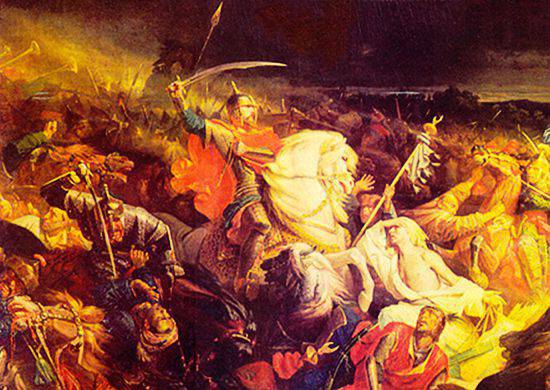
Such a construction was chosen taking into account the terrain and the method of struggle, which was used by the Golden Horde. Their favorite method was to reach out to one or both flanks of the enemy with cavalry detachments, and then to reach its rear. The Russian army took up a position that was securely covered from the flanks by natural obstacles. Under the terms of the terrain, the enemy could attack the Russians only from the front, which prevented him from using his numerical superiority and using the usual tactical technique. The number of Russian troops, built in combat order, reached 50 – 60 thousand people [6].
The Mamaia army, which came up in the morning of September 8 and stopped 7 – 8 kilometers from the Russians, numbered about 90-100 thousand people [7]. It consisted of the avant-garde (light cavalry), the main forces (in the center was hired Genoese infantry, and on the flanks - heavy cavalry, deployed in two lines) and reserve. In front of the Horde camp, light reconnaissance and security detachments crumbled. The idea of the enemy was to cover the Russian. army from both flanks, and then surround it and destroy. The main role in solving this problem was assigned to powerful horse groups concentrated on the flanks of the Horde army. However, Mamai was in no hurry to join the battle, still hoping for the approach of Jagiello.
But Dmitry Ivanovich decided to draw the army of Mamai into the battle and ordered his regiments to perform. The Grand Duke took off his armor, gave it to the boyar Mikhail Brenka, and he dressed himself in simple armor, but not inferior in its protective properties to the prince. The Grand Duke's dark red (cheremnoe) banner, a symbol of honor and glory of the combined Russian army, was placed in the Grand Regiment. It was given to Brenka.
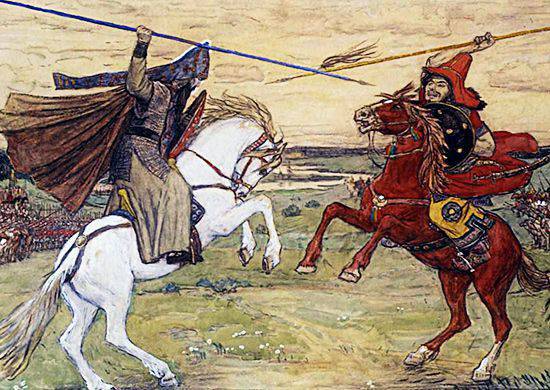
The battle began around 12 hours. With the rapprochement of the main forces of the parties, there was a duel between the Russian warrior, the monk Alexander Peresvet, and the Mongolian hero Chelubey (Temir-Murza). According to popular tradition, Peresvet left without protective armor, with one spear. Chelubey was fully armed. The warriors broke up the horses and hit the spears. Powerful simultaneous strike - Chelubey collapsed dead head to the Horde army, which was a bad omen. Over-the-light for several moments kept in the saddle and also fell to the ground, but head to the enemy. So the folk legend predetermined the outcome of the battle for a just cause. After the fight, a fierce slashing broke out. As the chronicle writes: “The power is great, the Tatar greyhound with Sholomiani is coming and that packs are not incoming, stash, for there is no place for them to fall apart; and Taco Stasch, the Master, the wall against the wall, every one on the curtains of his ancestors, the forerunners, and the rear ones owe. And the prince is great, too, with his great Russian strength from another Sholomiani poida against them ”[8].
For three hours, the army of Mamaia unsuccessfully tried to break through the center and the right wing of the Russian army. 3 here the onslaught of the Horde troops was repulsed. Actively acted detachment Andrei Olgerdovich. He repeatedly switched to a counterattack, helping the shelves of the center restrain the onslaught of the enemy.
Then Mamai concentrated his main efforts against the Left Arm regiment. In a fierce battle with a superior enemy, the regiment suffered heavy losses and began to retreat. In the battle was introduced reserve detachment Dmitry Olgerdovich. The warriors took the place of the fallen, trying to hold back the onslaught of the enemy, and only their death allowed the Mongolian cavalry to move forward. The soldiers of the ambush regiment, seeing the difficult position of their war brothers, were eager to fight. Vladimir Andreevich Serpukhovskaya, who commanded the regiment, decided to join the battle, but his adviser - an experienced voivode Bobrok kept the prince. Mamaev's cavalry, crushing the left wing and breaking through the battle order of the Russian army, began to go to the rear of the Big Regiment. Horde, supported by fresh forces from the reserve Mamaia, bypassing the Green Dubrava, attacked the soldiers of the Great Regiment.
The decisive moment of the battle has come. An ambush regiment rushed into the flank and rear of the Golden Horde cavalry which Mamai did not know existed. The strike of the ambush regiment was a complete surprise to the Tatars. “To the great fear and horror of the wickedness ... and vozkliknusha, utterly:“ Alas for us! ... Christians have pledged themselves over us, lutchia and distant riches and commanders left and left and prepared for us; but our hands are weak, and the shoulders of the Ustash, and the knees are numb, and our horses are worn out of exhaustion, and our weapons are broken; and who can against their stat? ... ”[9]. Using the emerging success, went on the offensive and other regiments. The enemy fled. Russian squads pursued him for 30 – 40 kilometers - to the Krasivaya Mecha River, where the wagon train and rich trophies were captured. Mamai army was completely defeated. It has almost ceased to exist [10].
Returning from the chase, Vladimir Andreevich began to collect troops. The Grand Duke himself was contused and knocked off his horse, but was able to reach the forest, where he was found after the battle under a cut birch in an unconscious state [11]. But the Russian army suffered heavy losses, which amounted to about 20 thousand people [12].
Eight days the Russian army collected and buried the killed soldiers, and then moved to Kolomna. September 28 winners entered Moscow, where they waited for the entire population of the city. The battle on the Kulikovo Field was of great importance in the struggle of the Russian people for liberation from the alien yoke. She seriously undermined the military power of the Golden Horde and accelerated its subsequent disintegration. The news that "Great Russia defeated Mamaia on the Kulikovo field" quickly spread throughout the country and far beyond its borders. For an outstanding victory, the people nicknamed the Grand Duke Dmitry Ivanovich "Donskoy", and his cousin, Serpukhov Prince Vladimir Andreevich - the nickname "Brave".
The Jagiello detachments, before reaching the Kulikov field 30-40 kilometers and learning about the victory of the Russians, returned to Lithuania with a speedy march. An ally of Mamai did not wish to take risks, since there were many Slavic detachments in his army. Prominent representatives of the Lithuanian soldiers who had supporters in the Jagiello army were present in Dmitry Ivanovich's rati, and they could go over to the side of the Russian troops. All this forced Yagaylo to be as careful as possible in making decisions.
Mamai, leaving his broken army, fled to a handful of comrades in Cafa (Theodosius), where he was killed. The power in the Horde seized Khan Tokhtamysh. He demanded that Russia resume the payment of tribute, arguing that in the Kulikovo battle, it was not the Golden Horde who suffered a defeat, but a usurper of power - Temnik Mamai. Dmitry refused. Then, in 1382, the city of Tokhtamysh undertook a punitive campaign against Russia, seized and burned Moscow with cunning. The largest cities of the Moscow land - Dmitrov, Mozhaisk and Pereyaslavl - were also subjected to merciless destruction, and then the Horde marched with fire and sword across the Ryazan lands. As a result of this raid, the Horde rule over Rus was restored.
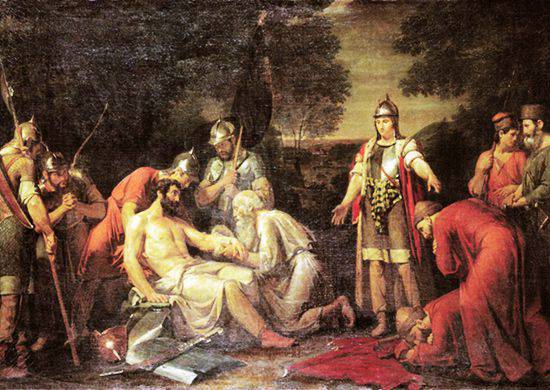
In its scale, the Battle of Kulikovo has no equal in the Middle Ages and occupies a prominent place in the history of military art. The strategy and tactics used in the Battle of Kulikovo by Dmitry Donskoy exceeded the strategy and tactics of the enemy, were distinguished by their offensive character, activity and determination of actions. Deep, well-organized intelligence allowed us to make the right decisions and make an exemplary march-maneuver to the Don. Dmitry Donskoy was able to correctly assess and use the terrain. He took into account the tactics of the enemy, revealed his plan.
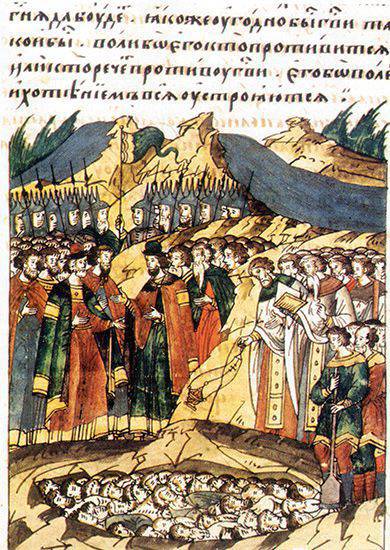
1380. Facial chronicle of the XVI century.
Based on the terrain conditions and the tactics employed by Mamai, Dmitri Ivanovich rationally placed the forces at his disposal on the Kulikovo Field, created a general and private reserve, thought out the questions of the interaction of the regiments. The tactics of the Russian army was further developed. The presence of a general reserve (the Ambush Regiment) in the battle formation and its skillful use, expressed in the successful selection of the moment of commissioning, predetermined the outcome of the battle in favor of the Russians.
Assessing the results of the Kulikov battle and the activities of Dmitry Donskoy preceding it, a number of modern scholars who studied this issue most fully did not consider that the Moscow prince had set himself the goal of leading the antiordian struggle in the broad sense of the word, but only opposed Mamai as a usurper of the Golden Horde. So, A.A. Gorsky writes: “Open insubordination to the Horde, which grew into an armed struggle against it, occurred at a time when power there fell into the hands of an illegitimate ruler (Mamaia). With the restoration of the "legitimate" power, an attempt was made to confine itself to a purely nominal, without paying tribute, recognition of the rule of the "king", but the military defeat of 1382 of the year tore it off. Nevertheless, the attitude towards foreign power has changed: it has become clear that under certain conditions it is possible to reject it and to successfully defeat the Horde [13]. Therefore, as noted by other researchers, despite the fact that appearances against the Horde still take place within the framework of previous ideas about the relationship between the Russian princes, the “ulus” and the Horde “kings”, “The Kulikovo battle undoubtedly became a turning point in the formation of the Russian self-consciousness [14], and “the victory on the Kulikovo Field secured for Moscow the value of the organizer and ideological center for the reunification of the Eastern Slavic lands, showing that the way to their state-political unity was the only tom and their liberation from foreign domination »[15].
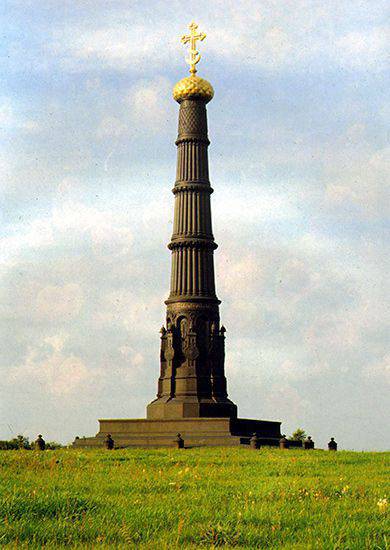
Installed on the Kulikovo Field in 1852 at the initiative of the first researcher
Battle of the Chief Prosecutor of the Holy Synod S. D. Nechaev.
Times Horde invasions of the past. It became clear that in Russia there are forces capable of resisting the Horde. The victory contributed to the further growth and strengthening of the Russian centralized state and raised the role of Moscow as a center of association.
[1] September 21 (September 8 on the Julian calendar) in accordance with the Federal Law 13 March 1995 No. 32-FZ “On Days of Military Glory and Memorable Days of Russia” is the Day of Military Glory of Russia - Victory Day of the Russian regiments led by Grand Prince Dmitry Donskoy over the Mongol-Tatar troops in the Battle of Kulikovo.
[2] Annals collection, called the Patriarch or Nikon chronicle. PSRL T. XI. SPb., 1897. C. 27.
[3] Cit. by: Borisov N.S. And the candle would not fade away ... Historical portrait of Sergius of Radonezh. M., 1990. C.222.
[4] Nikon chronicle. PSRL T. XI. C. 56.
[5] A. Kirpichnikov Kulikov battle. L., 1980. C. 105.
[6] This number is calculated by the Soviet military historian E.A. On the basis of the total population of the Russian lands, taking into account the principles of manning troops for all-Russian campaigns. See: E.A. Razin History of military art. T. 2. SPb., 1994. C. 272. The same number of Russian troops determines and A.N. Kirpichnikov. See: A.N. Kirpichnikov. Decree. cit. C. 65. In the writings of historians of the XIX century. this number varies from 100 thousand to 200 thousand people. See: N. Karamzin History of Russian Goverment. T. V. M., 1993.S. 40; Ilovaisky D.I. Collectors of Russia. M., 1996. C. 110 .; Solovyov S.M. The history of Russia since ancient times. Book 2. M., 1993. C. 323. Russian chronicles give extremely exaggerated data on the number of Russian troops: Resurrection chronicle - about 200 thousand. See: Resurrection chronicle. PSRL T. VIII. SPb., 1859. C. 35; Nikon Chronicle - 400 thousand. See: Nikon Chronicle. PSRL T. XI. C. 56.
[7] See: R.G. Skrynnikov Battle of Kulikovo // Battle of Kulikovo in the history of the culture of our Motherland. M., 1983. C. 53-54.
[8] Nikon chronicle. PSRL T. XI. C. 60.
[9] Ibid. S. 61.
[10] “Zadonshchina” speaks of the flight of Mamai himself-nine to the Crimea, that is, the death of 8 / 9 of the entire army in the battle. See: Zadonshchina // Military stories of ancient Russia. L., 1986. C. 167.
[11] See: The Tale of the Mamai Massacre // Military Tale of Ancient Russia. L., 1986. C. 232.
[12] A. Kirpichnikov Decree. cit. C. 67, 106. According to EA The Horde lost about 150 thousand, the Russians killed and died from wounds - about 45 thousand people (See: Razin, EA Decree. Op. 2 T. S. 287 – 288). B. Urlanis speaks about 10 thousand killed (See: Urlanis B.Ts. History of military losses. St. Petersburg., 1998. C. 39). The Tale of the Mamai Massacre states that the 653 boyar was killed. See: Military tales of ancient Russia. C. 234. The figure of the total number of dead Russian warriors in 253 thousand, cited there, is clearly overstated.
[13] Gorsky A.A. Moscow and the Horde. M. 2000. C. 188.
[14] I. Danilevsky Russian lands through the eyes of contemporaries and descendants (XII-XIV centuries.). M. 2000. C. 312.
[15] FM Shabuldo The lands of South-Western Russia as part of the Grand Duchy of Lithuania. Kiev, 1987. C. 131.
Information